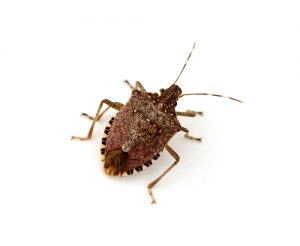How to Keep Stink Bugs Out!
By Chris Williams on May 30, 2011.
Q. I’ve been hearing a lot about this stink bug that is getting into homes. I haven’t seen any in my house yet. What should I be looking for?
A. You’re talking about the brown marmorated stink bug (we call it BMSB, for short), a new invasive pest that was first found in Pennsylvania about 10 years ago. It has since spread to 29 states by flying and hitchhiking on vehicles and shipped products. But not every home in the Northeast is going to see an invasion of stink bugs. They are very regional. You are more likely to see them if you live near agricultural fields or orchards since they feed mostly on crops and fruit trees, or if your home is surrounded by bright lights since they fly to lights.
The BMSB has a typical stink bug shape (see Occasional Invaders in our Pest Library) and is about 1/2-inch long. It has a marbled coloration and distinctive black and white banded legs and antennae that tell it apart from most other stink bugs.
 This stink bug becomes a problem mostly in the fall when it flies from its feeding sites and looks for a place to spend the winter. In areas with heavy populations, there can be thousands massing on the side of a home looking for a way inside. Most people just see a few bugs wandering around aimlessly inside or out. Once the stink bugs are inside, they find a hiding place, typically behind baseboards, around window and door trim, around ceiling lights, or in wall or ceiling voids. You probably won’t see them again until the first warm days of spring (or sometimes on warm days in the winter) when they become active, move out of their hiding places, and look for a way to get back outside.
This stink bug becomes a problem mostly in the fall when it flies from its feeding sites and looks for a place to spend the winter. In areas with heavy populations, there can be thousands massing on the side of a home looking for a way inside. Most people just see a few bugs wandering around aimlessly inside or out. Once the stink bugs are inside, they find a hiding place, typically behind baseboards, around window and door trim, around ceiling lights, or in wall or ceiling voids. You probably won’t see them again until the first warm days of spring (or sometimes on warm days in the winter) when they become active, move out of their hiding places, and look for a way to get back outside.
The good news is that these stink bugs don’t bite or sting, or reproduce indoors. The bad news is that they can give off an odor, mostly when irritated or squashed. Some say the odor is not so bad, that it smells like cilantro. Others say sweaty sneakers! The odor can be a problem if you are trying to vacuum up the bugs.
For homes that have large stink bug invasions, a pesticide treatment of outside walls in early fall is usually necessary to keep the bugs from getting in. Making sure screens on windows and vents are tight, and caulking of any openings (such as around utility lines) on the outside of the house, and openings between living spaces and the attic (such as around ceiling light fixtures or exhaust fans) will help keep them out, too. Remove window air conditioners after mid-September since this is a common point of entry. Once the stink bugs are inside, pesticides are not very effective. For just a few bugs inside, don’t squash; vacuuming is still your best option. Do so carefully and be sure to put the vacuum bag in the garbage after.